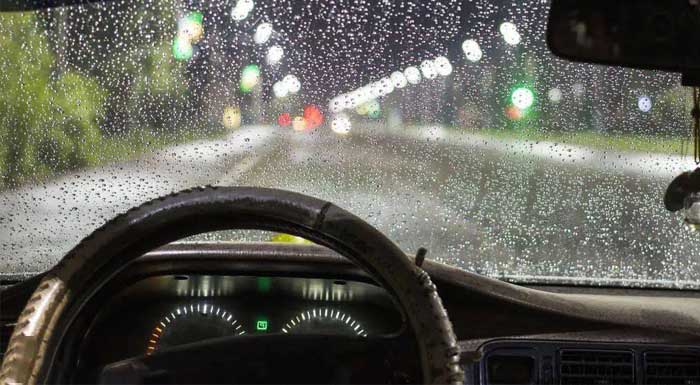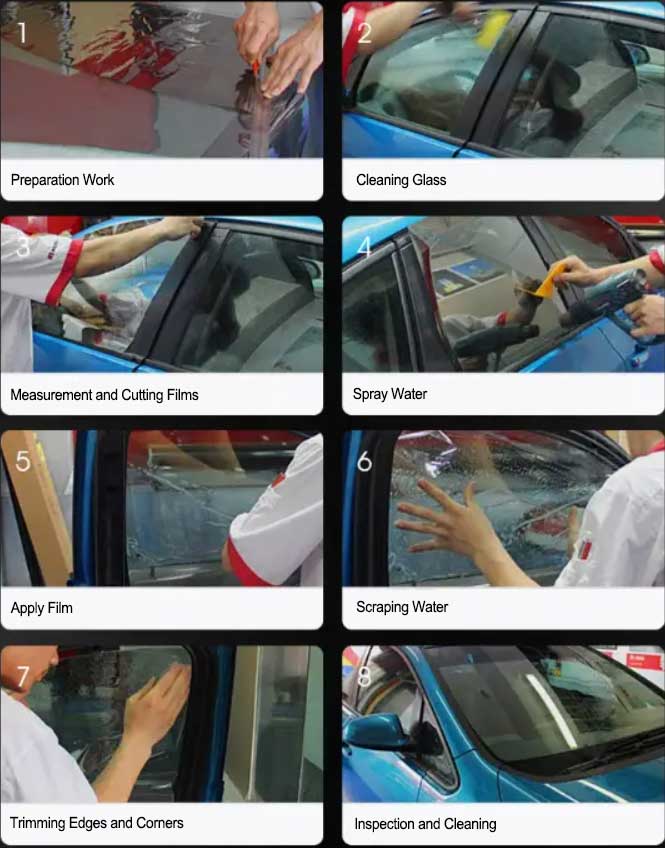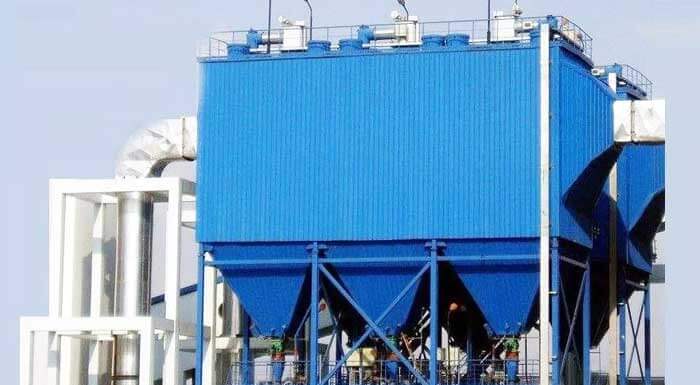Why Apply Automotive Films | How To Choose and Diy Automotive Film?
Why do we need to apply film to car windows? Automotive film is a thin film like object applied to the front and rear windshields, side windows, and sunroof of a vehicle, which is also known as a solar film or insulation film. It has the following benefits:

- Heat Insulation and Sun Protection: Automotive film can block the infrared rays in sunlight, reduce the temperature inside the car, improve ride comfort, and reduce the use of air conditioning, thereby reducing fuel consumption.
- UV Protection: Automotive film can effectively isolate UV rays, protecting occupants and interior from UV damage.
- Privacy Protection: The unidirectional perspective performance of car film can protect the privacy of passengers inside the car, making it impossible to see the inside of the car clearly from the outside.
- Explosion Proof: Good automotive film has flexibility, can resist penetration, prevent glass splashing in case of accidental impact, and reduce injuries to drivers and passengers.
- Anti Glare: The anti glare performance of automotive film can effectively reduce dazzling glare and improve driving safety.
- Security and Theft Prevention: Within 5 seconds, thieves can smash the car window and rob your belongings inside the car. If there are people inside the car at this time, the danger is even more self-evident, and the security car wrap is the most effective weapon to prevent such thieves from attacking.
- Durable and Scratch Resistant: Each car film surface is coated with advanced scratch resistant coatings to avoid scratches on the window surface caused by frequent lifting and lowering of the window glass and external force squeezing.
- Improving Aesthetics: After vehicle wrapping , personalized automotive films can be chosen according to personal preferences to enhance the vehicle’s aesthetics.
How To Choose a Automotive Film for your Vehicle
When choosing a automotive film, it is important to pay attention to the following points:

①. Choose Brand Films: Do not use inferior films, choose films with high brand awareness and stable quality.
International leading car film brands: Weigu, 3M, Johnson&Johnson, Dragon Film, Quantum Film.
②. Choose Films According To Demands: for example, the film on the front windshield should have a high light transmittance, while the side windows and rear windshields can choose darker films to increase privacy.
Translucency is the most important safety indicator of automotive film, which directly determines the quality of our driving vision. Especially in harsh weather or nighttime driving environments, low light transmittance can make it difficult for us to see the road clearly while driving, leading to eye fatigue and blind spots.
③. Wear Resistance, light Transmittance, Reflectivity and Viscosity: A automotive film with good wear resistance can maintain clarity for a long time, a automotive film with high light transmittance has a clear line of sight, and a automotive film with good viscosity is not easy to bubble.
Visible light reflectance is an important technical indicator for automotive film application. The higher its value, the stronger the reflected light and the greater the reflection. And it can be divided into internal reflectivity and external reflectivity, and our general focus is on this internal reflectivity.
The internal reflectivity is the reflection of light observed by a person inside a car. The higher this value, the stronger the reflection on the glass surface inside the car, which has a greater impact on the driver’s line of sight. When the internal reflectivity exceeds 20%, it will have a significant impact on driving in some special situations, such as rainy days, early morning, and night.
The reflectivity of high-quality car film is generally below 10%.
④. Thermal Insulation and Sun Protection: Choose a film that can block UV rays and heat, improving driving comfort and safety.
A good car insulation film can reflect or block most of the solar energy, reduce the temperature inside the car, and then reduce the air conditioning load to save fuel. Whether the car film is insulated or not mainly depends on the total blocking rate of solar energy.
The higher the total solar energy barrier rate, the better the thermal insulation performance of the coated glass. The total solar light blocking rate of mainstream solar films is generally around 30% to 40%. The coating process of the inner layer of the film is a key factor in determining the insulation effect.
A high UV blocking film can block most of the ultraviolet light entering the car, effectively protecting the human skin and interior equipment.
⑤. Safety of Car Wraps: Choose a film with explosion-proof and splash proof properties to improve driving safety.
⑥. Warranty Period: Regular brand car films will provide after-sales quality assurance services, usually with a shelf life of 5 years. It is best to confirm in advance when purchasing car films.

At present, the automotive film on the market can be roughly divided into 5 types: dyed film, ordinary metal film, magnetron sputtered metal film, nano ceramic film, and optical film.
Purchasing Suggestion: When the budget is sufficient, it is recommended to prioritize nanoceramic films and magnetron sputtering metal films. Car owners who pursue versatility and have strong financial resources may consider optical films.
How To DIY Automotive Films
DIY automotive film application requires certain skills and precautions. Here are some steps and suggestions:

1. Preparation Work: Firstly, ensure that the working environment is dry and dust-free, and prepare tools suitable for glass film application, such as cleaning agents, scrapers, fine bristled brushes, glue scrapers, cutting knives, water spray bottles, etc.
2. Cleaning Glass: Clean the surface of the glass to remove dust, stains, and grease, and use specialized cleaning agents and fine bristled brushes for cleaning. Ensure that the glass surface is clean so that the film can tightly adhere to the glass.
3. Measurement and Cutting Films: According to the size of the glass, use a ruler and cutting knife to cut the film to an appropriate size. Be careful not to cut too large or too small, leaving appropriate margin. At the same time, ensure that the surface of the film is free of scratches, bubbles, or impurities.
4. Spray Water: Spray an appropriate amount of water on the surface of the glass to better enhance the adhesion of the film. Be careful not to spray too much water to avoid affecting the adhesion of the film.
5. Apply Film: Tear off the cut film, spray water evenly on the effective film surface, and then apply it to the glass. Be sure to apply water evenly to ensure that there are no bubbles or wrinkles on the surface of the film. At the same time, it is important to avoid excessive stretching of the film to avoid wrinkles or bubbles.
6. Scraping Water: Use a scraper to gently scrape out the moisture and bubbles under the film, being careful not to scratch the surface of the glass. At the same time, it is necessary to ensure that the force of the scraper is moderate to avoid affecting the adhesion and flatness of the film.
7. Trimming Edges and Corners: Use a cutting knife to trim the edges and corners of the film neatly to match the surface of the glass. Be careful when operating to avoid scratching the glass surface.
8. Inspection and Cleaning: Check if the film is flat, free of bubbles, wrinkles, and if the edges are neat. If there are any problems, make timely adjustments and handle them. Finally, use a clean cloth to wipe the water off the edges of the glass.
It should be noted that DIY automotive films application requires a certain level of patience and skill. If you are unsure of your abilities or lack experience, it is recommended to seek professional help or guidance. In addition, selecting the appropriate film and tools is also very important to ensure the quality and effectiveness of the film.
 How To Choose A Suitable Filter Bag for your Bag Filter
How To Choose A Suitable Filter Bag for your Bag Filter



